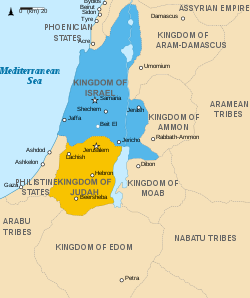
Back Geskiedenis van antieke Israel en Juda Afrikaans Geschichte Israels ALS تاريخ مملكتي إسرائيل ويهوذا القديمتين Arabic Historia del Israel antiguu AST Боронғо Израиль һәм Йәһүдиә тарихы Bashkir Història de l'antic Israel Catalan Starověké dějiny Židů Czech Oldtidens Israels og Judæas historie Danish Geschichte Israels German History of ancient Israel and Judah English

Israel and Judah were Iron Age kingdoms of the old Near East. The area of time covered in this page is from the first mention of the name Israel in the archaeological record (1200 BCE) to the end of a independent Judean kingdom near the time of Jesus Christ.
The two kingdoms arose on the eastern coast of the Mediterranean, the most western part of the Fertile Crescent, between the old empires of Egypt to the south, Assyria, Babylonia, later Persia to the north and east, Greece and later Rome across the sea to the west. The area is small, maybe only 100 miles north to south and 40 or 50 miles east to west.
Israel and Judah were from the Canaanite culture of the late Bronze Age, and were based on villages that formed and grew in the southern Levant highlands (today for the region between the coastal plain and the Jordan Valley) between c. 1200-1000 BCE. Israel became an important local power in the 9th and 8th centuries BCE before falling to the Assyrians. The southern kingdom, Judah, became rich inside the greater empires of the region before a revolt against Babylon led to it being destroyed early in the 6th century.
Judean exiles returned from Babylon early in the following Persian period, starting a Judahite presence in the province of Yehud, as Judah was now called. Yehud was absorbed into the subsequent Greek-ruled kingdoms which followed the conquests of Alexander the Great. In the 2nd century BC, the Jews went up against Greek rule and created the Hasmonean kingdom, which became first a Roman dependency and soon went under the rule of the Roman Empire.